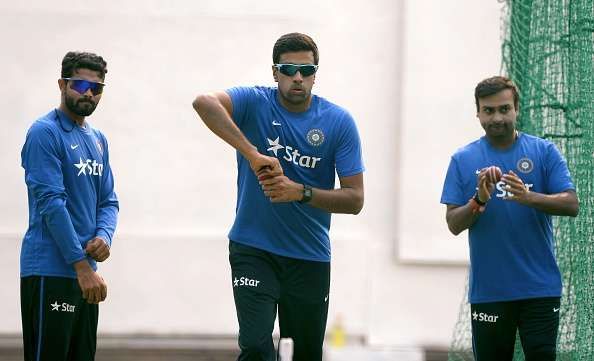
Has the pitch at Rajkot done India more harm than good?
Much like Virat Kohli’s words, surprise was the emotion that would have been elicited the most among arm-chair critics and commentators after the first Test between India and England at Rajkot. Not just at the fact that India didn't win, but also at just how easy it was for England to get settled at the start of what should be an arduous three-month long tour of India.
Traditionally a high-scoring ground, as evident from the pre-match first innings first-class average score of 397, the pitch at Rajkot was expected to favour the batsman and the grass on day one was to ensure that the pitch didn't crumble early in the match.
Also Read: Virat Kohli reveals the reason behind selecting three spinners at Rajkot
But instead of favouring the batsman and assisting the bowlers in the last couple of days, Rajkot merely sent out an open invitation for a buffet of runs that was unsurprisingly gobbled up in a jiffy by the batsmen. How else do you explain 1,457 runs being scored for the loss of just 29 wickets and both teams scoring more runs in their first innings than the entirety of the second Test between India and New Zealand held last month.
There are pitches that offer some assistance to seamers early in the game, those that assist spinners late in the game and ones that offer extreme assistance to one or the other right through the game. The surface being used at Rajkot was one that batsmen would love to carry with them any day of the week and use for practice when they are in a slump.
Odds being decked heavily in favour of a particular skill is one thing but for an Indian pitch to only offer consistently considerable turn late on the fifth day is not only uncommon but also unnatural and against the true nature of the pitches in the country.
England off to the perfect start
So what has the pitch at Rajkot done for both India and England? For starters, it has made it easy for the English batsmen to get in at the start of a gruelling winter where many expected them to suffer a whitewash and few expected draws, let alone wins from the five-match Test series.
And let's not forget that this is the same England side who almost lost a two-match series to Bangladesh and only just survived a draw thanks to some poor batting from Bangladesh's batsmen in the first Test. Alastair Cook, who is undoubtedly England's best batsman in Asia, came away from the series with an aggregate of 89 runs from four innings.
Also Read: India vs England, 1st Test Stats: Alastair Cook's incredible Test record in India
But what this Rajkot pitch has done is not only feed the ever run-hungry Cook to some easy runs to feast upon, but also gave all-rounders like Moeen Ali and Ben Stokes, who were playing their first Test in India, an easy pass on what is supposed to be one of the toughest away assignments in international cricket.
Ahead of a long Test series in conditions that are alien to most of the current crop of English players, the last thing India would have wanted to do was to give them an opportunity to score easy runs without having to work too hard for it. But the pitch at Rajkot did exactly that, as was evident from the fact that not only did four different English players score centuries but also gave the 19-year-old debutant a smooth ride into international cricket.
While raging turners that ensure Tests ending in two days or green seamers which ensured the match doesn't go past three days shouldn't be encouraged, nor should a pitch as flat as Rajkot was, where it is as much of an even contest between bat and ball as it is in limited-overs cricket.
If the batsmen have it all their way, not only will they score bucket load of runs and swell up their average, but will also find it incredibly difficult any time they are given a pitch that offers more of an even contest, or even one that is tilted in favour of the bowlers. Just ask Australia – who are currently suffering at the hands of South Africa at home – about the perils of batsman-friendly home wickets and they will tell you all about it.
Spinners losing confidence in India
While fuelling the visiting beast is one thing, draining the lifeblood out of your greatest asset (i.e., spinners) doesn't seem like a fool-proof plan. Even if Kohli wouldn't admit it, England's spinners performed statistically better than their Indian counterparts in the first Test.
While that is a concern, the fact that India's spinners bowled on days one and two, where the pitch was flatter than a national highway and England's spinners got to bowl when the pitch finally decided to offer some assistance to the bowlers, undermines the grave threat that the statistics immediately present.
However, what is a worry is if spinners, who are under pressure to perform at home, continue to get surfaces similar to what they got at Rajkot, grow demoralised if even pitches at home don't allow them to thrive.
While this shouldn't be an outcry to get in pitches that turn square from day one and make batting a nightmare, it certainly would help, if Indian pitches, which traditionally take turn, do so, earlier than the final session of the final day of the match as was the case at Rajkot.
So, irrespective of what happens going forward in this series, beginning with the second Test at Vizag, there has already been some damage done to India's chances of avenging their previous series losses to England.
Whether it was the prospect of the hosting its first Test or the fact that the last two days fell on a weekend, thereby giving more financial incentive to have a Test run into the final day, the pitch at Rajkot has already given England an advantage they couldn't possibly have accounted for.
Surprises might make life more interesting but the pitch at Rajkot was one of those that Virat Kohli and India could have done without.

